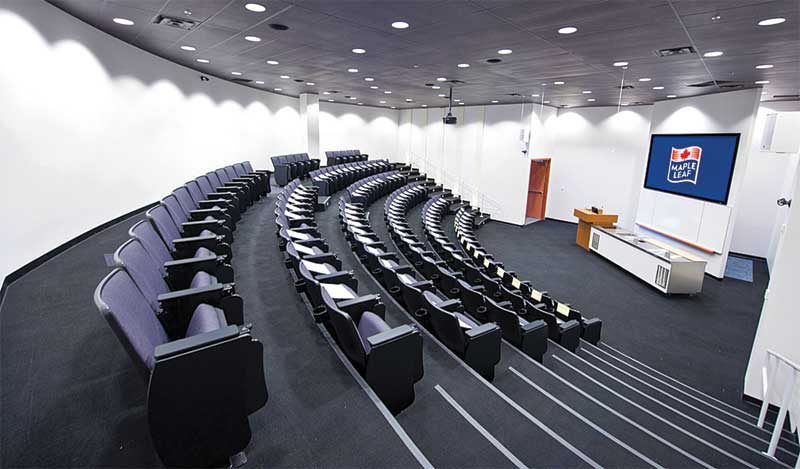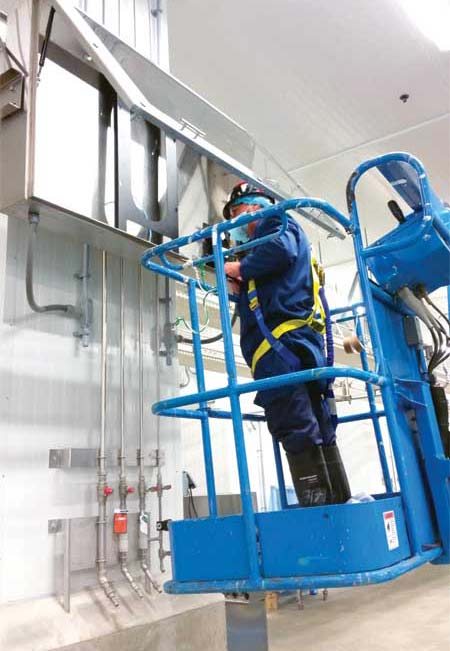Doing it all

Maple Leaf Foods’ digital branding helps the company foster a strong corporate identity, culture, and vision.
Technology is constantly evolving. As such, the panacea of consumer engagement is often diverted to what is cool, sexy, and new in the marketplace. We are all intrigued by how augmented/virtual reality, artificial intelligence, holographic telepresence, and other smart technologies are evolving. However, this is ultimately a trap if they do not have applications that are tied to network goals. It is never about digital for the sake of digital.
As such, subject matter experts are now defined differently. The skill set of systems integrators have changed in a big way. While listening and understanding business issues from a client in concert with the needs of the viewing audience sounds simple, it is not. Are solutions tailored to fulfil client needs—or are they simply ‘off the shelf’?
AV has consistently played a key role in the overall digital signage solution. End-users have always looked for ‘one-stop’ providers who are capable of supplying and managing all aspects of the solution, including strategy, displays, media players, installation, content production, and ongoing support. The ‘total solution’ has always been where the big opportunities lie.
AV providers who have already embraced this concept and integrated these disciplines into their organizations have seen long-term success in the digital signage space. Likewise, others have partnered with organizations that could provide the aspects of the solution outside of the AV components.
This scenario has not had long-term traction for most, primarily because the barriers for entry on the AV side—for the most part— have gone away. Displays are readily available. They cost less, are easy to install, and are durable enough to last a long time. These factors make it easier for other stakeholders (or the end-user) to supply the AV components of a solution.
Services are consistently in demand and, unlike hardware components, do not easily fall prey to commoditization. This is where AV is able to play a major role within the digital signage space, as all of the functions done well in AV remain in demand in the digital signage world (e.g. on-site service, remote monitoring warranty service, etc.).

Dot2Dot Communications worked with Maple Leaf Foods to design a number of strategic information solutions.
Outstanding service, great value, and strong products always win in the long term.
Moving forward
Once kept definitively separate, digital signage and AV technologies now exist within the same realm—and will not be reverting any time soon.
“The lines have indeed blurred in recent years in regards to digital signage and AV,” says Richard Ventura, vice-president (VP) of strategic management for NEC Display Solutions. “In the early days of digital signage, it was preferred to be specialized and separate from the AV space; however, as digital signage matured, the two distinct areas have grown to complement one another. Systems have become easier to use and the focus from manufacturers and integrators have been able to bridge the gap and deliver complete technology solutions. Digital signage has become a necessity.”
Further advancements in display technology will continue to drive video walls to grow incrementally in the AV space. This will lead to incredible digital signage deployments across many verticals, as already witnessed in airports, retail, school campuses, and out of home (OOH) space.
The age of real-time information—the ‘when I want it and how I want it’ mentality—lends itself to technology advancements that will almost certainly continue to sprint forward. This is indeed an exciting time for innovative digital signage solutions.
Andy McRae is general manager for Dot2Dot Communications, while Mark Mantha provides market development consulting for Dot2Dot, a full-service visual communications company that designs, develops, and manages immersive digital signage experiences. For more information, visit www.dot2dotcommunications.com.





